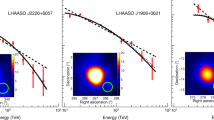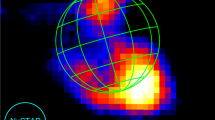Abstract
The COS-B source CG135+1 (ref. 1) is an extremely interesting object because of its possible identification with the QSO 0241+622. Radio observations have identified a strong point source within 2 arc s (ref. 2) of QSO 0241+622. X-ray emissions have also been observed from this region of the sky by the Uhuru (ref. 3), SAS-3 (ref. 2) and HEAO-A (ref. 4) telescopes. The HEAO-A (A1) data indicate that there are two soft X-ray sources in this region of the sky, H0241+62 which contains the QSO, and H0235+60 which includes the radio source GT0236+61 (ref. 5). The OSO-7 data in the energy range 1–40 keV (ref. 6) and measurements using the high-energy X-ray experiment on Ariel-V between 0.26 and 1.2 MeV (ref. 7) have indicated that the photon emission from this region of the sky is of an extremely hard nature, with a power law spectral index of γ≈1.0. However, the poor angular resolution of these telescopes make it uncertain whether the high-energy X-ray fluxes are due to the same celestial object. We now report the results of a balloon flight carried out on 8 October 1978 from Palestine, Texas, in which the region of the sky including the COS-B source CG135+1 was scanned by the Milan/Southampton telescope (MISO telescope). A 5σ excess in the counting rate of the telescope in the energy range 0.15–20 MeV was observed. The origin of this low-energy γ-ray emission is compatible with the measured position of CG135+1.
This is a preview of subscription content, access via your institution
Access options
Subscribe to this journal
Receive 51 print issues and online access
$199.00 per year
only $3.90 per issue
Buy this article
- Purchase on Springer Link
- Instant access to full article PDF
Prices may be subject to local taxes which are calculated during checkout
Similar content being viewed by others
References
Hermsen, W. et al. Nature 269, 494 (1977).
Apparao, K. M. V. et al. Nature 273, 450 (1978).
Forman, W. et al. CFA preprint No. 763 (1977).
Share, G. M. et al. Proc, XXI Cospar Meet. Innsbruch (1978).
Gregory, P. C. et al. Nature 273, 704 (1978).
Maraschi, L. et al. Nature 272, 679 (1979).
Coe, M. J. et al. Nature 279, 343 (1978).
Baker, R. E. et al. Nucl. Instrum. Meth. 158, 595 (1979).
Author information
Authors and Affiliations
Rights and permissions
About this article
Cite this article
Ventura, A., Perotti, F., Villa, G. et al. Evidence for low-energy γ-ray emission close to CG135+1. Nature 282, 486–487 (1979). https://doi.org/10.1038/282486a0
Received:
Accepted:
Published:
Issue Date:
DOI: https://doi.org/10.1038/282486a0
This article is cited by
-
Low-energy gamma-ray sources observed by the MISO telescope
Il Nuovo Cimento C (1984)
Comments
By submitting a comment you agree to abide by our Terms and Community Guidelines. If you find something abusive or that does not comply with our terms or guidelines please flag it as inappropriate.



